As the cold weather starts to come on, many of us sigh and look forward to the start of the spring again, when we can once more grow fresh vegetables and fruit for our tables. But it doesn’t have to be like that! There’s many cold-weather vegetables that can easily grow with just a little protection. And building a cold frame is the perfect solution.
While a cold frame can be as simple and small as a plastic 2-liter bottle with the bottom cut off, carefully placed overtop of a plant to offer a little more warmth, what I’ve got for you today is a list of 26 different concepts and plans for winter cold frames that encompass a bit more space in your garden and allow for a better collection of vegetables. So whether you’d like to grow spinach or beets, protect your flowers or even start a few seedlings early on, there’s a plan here for everyone.
Since there’s a variety of materials that can be used to construct cold frames, I’m going to split these up by the clear material used on the top of the frame. From there, the only limit is your imagination!
Subscribe to the Epic Gardening Podcast on iTunes
Plastic Sheeting/Soft Plastic Cold Frames
Simple Cold Frame
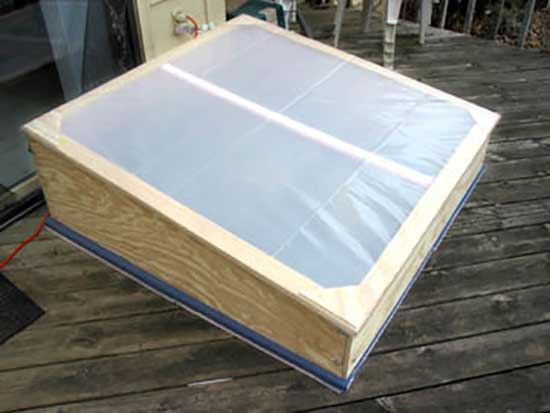 Simple Cold Frame. source
Simple Cold Frame. sourceThis particular cold frame is not elaborate, but it works quite well. Made of plywood and poly sheeting, its sloped shape allows for rain drainage while keeping the plants within warm in the cooler months of the year.
| Materials: | Plywood, poly sheeting, misc tools and bolts/nuts/screws. |
| Dimensions: | 4’ wide x 4’ deep, sloped top peaks at 15” |
| Difficulty: | Beginner to intermediate |
| Cost: | $$ |
Build This Cold Frame >
PVC Cold Frame
 PVC Cold Frame. source
PVC Cold Frame. sourceConstructed entirely of PVC and plastic sheeting, this basic PVC frame keeps warmth inside and allows ease of access through its triangular hinged roof. The plastic sheeting can be easily replaced year after year as needed.
| Materials: | PVC and PVC connectors, 6mil clear plastic sheeting, pipe glue |
| Dimensions: | 4’ wide x 2’ 4” deep |
| Difficulty: | Beginner |
| Cost: | $ |
Build This Cold Frame >
Lightweight Lid Cold Frame
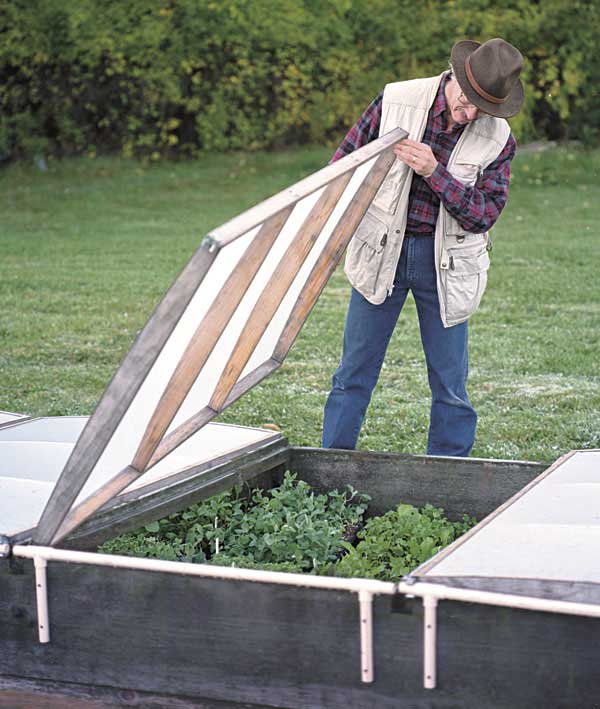 Lightweight Lid Cold Frame. source
Lightweight Lid Cold Frame. sourceThis fascinating, lightweight cold frame was designed for use with an temperature-controlled automatic opening vent, and it’s really cool! If you’re concerned that your plants will get too warm while you’re at work during the day, this design is perfect, as the lid will open itself and close itself in response to the ambient temperature.
| Materials: | Lightweight wood, 8mil vinyl sheeting, PVC pipe, automatic venting control (like a Univent) |
| Dimensions: | 3’ wide x 6’ long |
| Difficulty: | Intermediate |
| Cost: | $$$ |
Build This Cold Frame >
Cold Frame Tent
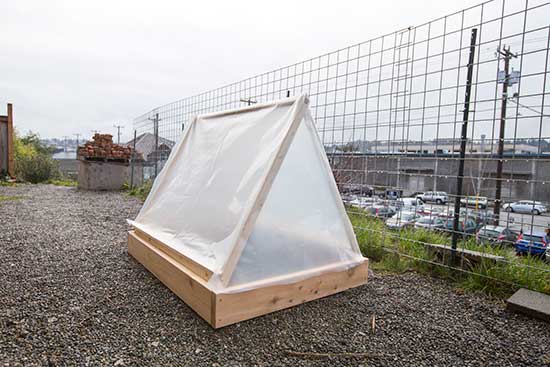 Cold Frame Tent. source
Cold Frame Tent. sourceIf you have existing raised beds, all you need is the top for this to rest on top of your beds. If you don’t, add a box around your garden plot, and with very little difficulty, you are set up to endure the weather while still growing plants to a reasonable height!
| Materials: | Heavy plastic sheeting, lumber, a hardwood dowel, screws or nails |
| Dimensions: | Variable depending on need |
| Difficulty: | Beginner to intermediate |
| Cost: | $-$$ |
Build This Cold Frame >
Sleek & Efficient Cold Frame
 Sleek and Efficient Cold Frame. source
Sleek and Efficient Cold Frame. sourceThis functional cold frame is intended to be constructed for an already-existing raised bed. While a slight variation to the design would enable runoff from rains to move more easily, it’s a great option for people in cold but less-rainy environments just as it is already.
| Materials: | Lumber, heavy plastic sheeting, screws or nails |
| Dimensions: | 4’ wide x 8’ deep x 15” tall |
| Difficulty: | Beginner |
| Cost: | $ |
Build This Cold Frame >
PVC Cold Frame Hoop House
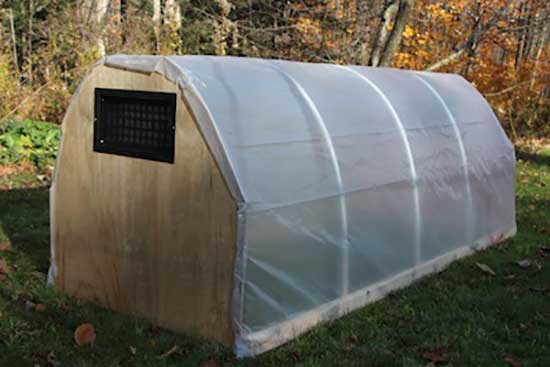 PVC Cold Frame Hoop House. source
PVC Cold Frame Hoop House. sourceThis arched hoop house-style cold frame is not elaborate, but it does the trick! Made to fit just inside the walls of a raised bed, the two plywood ends keep wind out of the tunnel, and the plastic sheeting overtop allows plenty of light to reach your plants.
| Materials: | PVC, plastic sheeting, plywood, 2×3 studs, misc screws and other assorted equipment |
| Dimensions: | Variable, can be adjusted to fit most raised beds |
| Difficulty: | Beginner to intermediate |
| Cost: | $-$$ |
Build This Cold Frame >
Amish Cold Frame
 Amish Cold Frame. source
Amish Cold Frame. sourceThis one does not come with exact plans, so it takes a little bit of plotting to recreate it. However, it’s a simple enough structure. It’s adorably cute, as it looks like a little house, and it’s incredibly useful, as only half the lid needs to be lifted to access the plants inside or to provide ventilation.
| Materials: | Lumber, plastic sheeting, hinges, nails or screws, and a chain with spring for each end |
| Dimensions: | 66” long x 24” wide |
| Difficulty: | Intermediate |
| Cost: | $$ |
Build This Cold Frame >
Plastic Bottle Cold Frame
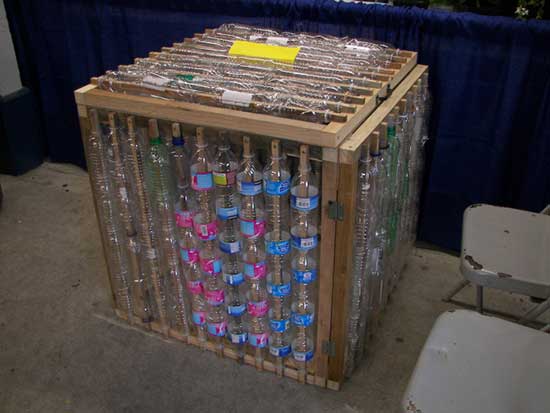 Plastic Bottle Cold Frames. source
Plastic Bottle Cold Frames. sourceDo you find that plastic water bottles build up in your house or recycling bin? Well, save some, and you too can create this unusual, but effective cold frame! If you add a little silicone caulk between the bottles, you can make it completely enclosed, or you can leave the gaps to allow some vent space. Whichever you do, this reuse project makes the most of what would otherwise be landfill fodder or recycling plant materials.
| Materials: | Empty plastic bottles, wood doweling or slats, lumber, screws or nails, silicone caulk (optional) |
| Dimensions: | Variable depending on size desired |
| Difficulty: | Beginner to intermediate |
| Cost: | $ |
Build This Cold Frame >
Hard Plastic, Acrylic, or Plexiglass Cold Frames
Quick ‘n Easy Cold Frame
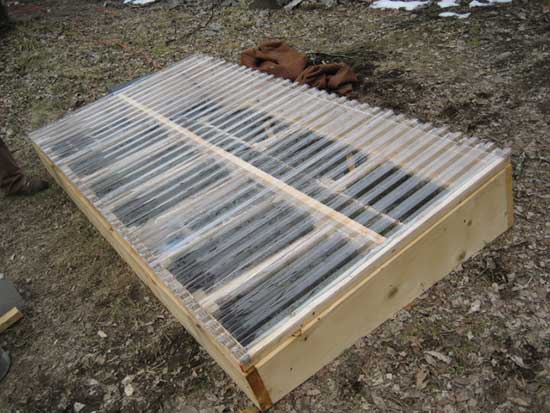 Quick n’ Easy Cold Frame. source
Quick n’ Easy Cold Frame. sourceThis cold frame is a really interesting design. While not the least expensive option due to the polycarbonate panels used for the top of the frame, it’s definitely one of the longest-lasting options, and is resistant to tearing or breakage of the sunlight panel. This style will last for years and years of use!
| Materials: | Translucent polycarbonate panels and their fasteners, lumber, silicone caulking, hinges and misc screws |
| Dimensions: | 8’ wide x 4’ deep x 1’ tall |
| Difficulty: | Intermediate |
| Cost: | $$$ |
Build This Cold Frame >
Portable Cold Frame
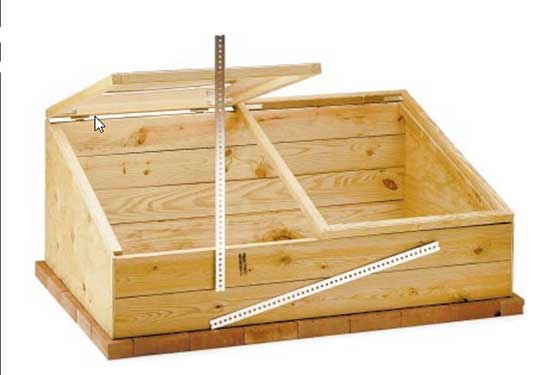 Portable Cold Frame. source
Portable Cold Frame. sourceIf you don’t have raised beds, this cold frame might be a great option for you. Brick forms a flat support at the base and helps to keep the soil warmed by the sun. The box is inexpensive plywood, and the only expensive part is clear acrylic glazing panels which you can pick up at most big-box hardware stores. The acrylic resists ice buildup, which adds an extra layer of protection.
| Materials: | Acrylic glazing, plywood, bricks, screws, hinges |
| Dimensions: | 61” wide x 37 ½” deep x 24” tall |
| Difficulty: | Beginner to intermediate |
| Cost: | $$ |
Build This Cold Frame >
Plexiglass Cold Frame
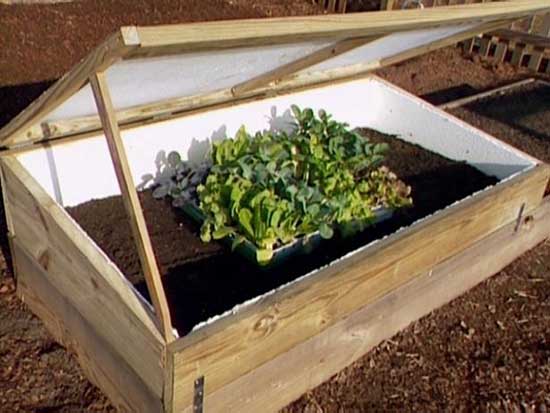 Plexiglass Cold Frame. source
Plexiglass Cold Frame. sourceThis plexiglass-topped cold frame offers a rigid surface that will repel snow and rain, but which also will allow plenty of light through to the plants below. It’s not the cheapest option, but it’s one of the strongest on the list! You can also modify this to use an old door in lieu of the plexiglass if you’d like.
| Materials: | Plexiglass sheeting, lumber, hinges and assorted screws/tools |
| Dimensions: | 6’ wide x 3’ deep, but can be variable if using old door instead of plexiglass |
| Difficulty: | Beginner to intermediate |
| Cost: | $$ |
Build This Cold Frame >
Raised Bed Cold Frame
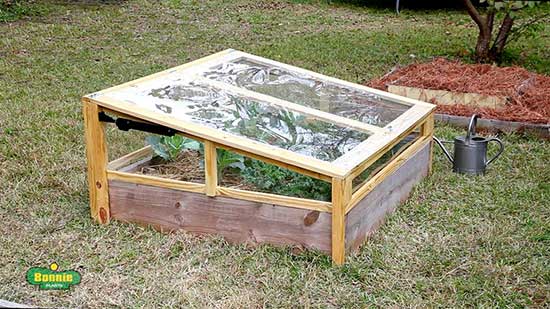 Raised Bed Cold Frame. source
Raised Bed Cold Frame. sourceDesigned to sit on top of a 4’x4’ raised bed, this cold frame is an easy build and works extremely well. The sloped lid provides rain runoff. Best of all, the whole thing can be lifted off the raised bed when the weather is warmer, as it’s fairly lightweight.
| Materials: | Lumber, acrylic sheets, screen door pneumatic closers, misc screws and hinges |
| Dimensions: | Fits overtop a 4’ x 4’ raised bed |
| Difficulty: | Beginner |
| Cost: | $$ |
Build This Cold Frame >
Dead Simple Cold Frame
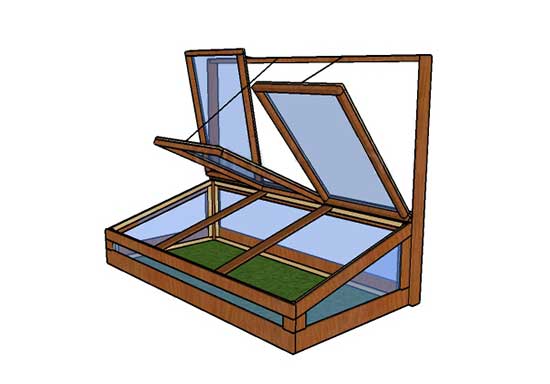 Dead Simple Cold Frame. source
Dead Simple Cold Frame. sourceAs the name would imply, this cold frame is dead simple to build. The most complex part of the entire build is getting the angled top right. Otherwise, it’s something that can easily be knocked together in a couple hours’ time!
| Materials: | Lumber, greenhouse plastic, misc screws |
| Dimensions: | 8’ wide x 4’ deep x 25” tall |
| Difficulty: | Beginner |
| Cost: | $$ |
Build This Cold Frame >
Glassless Cold Frame
 Glassless Cold Frame. source
Glassless Cold Frame. sourceOn occasion, you can find old skylight domes that have been removed because they’ve started to leak at the sides. But these don’t have to be thrown away! Give them new life by using the dome as a top for a cold frame! A simple box base supports the skylight dome, allowing you to grow your plants right underneath.
| Materials: | Old skylight dome, lumber, screws |
| Dimensions: | Depends on size of skylight dome |
| Difficulty: | Beginner |
| Cost: | $$ |
Build This Cold Frame >
Cold Frame Table
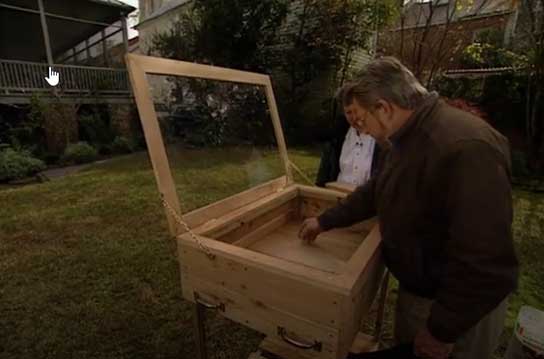 Cold Frame Table. source
Cold Frame Table. sourceThis cold frame actually sits up above the ground, like a table, and is perfect for starting seeds in the winter! With a clear acrylic sheet on top, plenty of light hits the inside, and there’s a handy shelf underneath which provides a little extra storage space. Best of all, when it’s not in use as a cold frame, it can be repurposed as a handy potting table. The instructions are in a handy video format.
| Materials: | Clear sheet acrylic, lumber, screws or nails, hinges |
| Dimensions: | 2’ wide x 3’ deep x 38” tall |
| Difficulty: | Intermediate |
| Cost: | $$ |
Build This Cold Frame >
Glass Topped Cold Frames
Salvaged Window Cold Frame
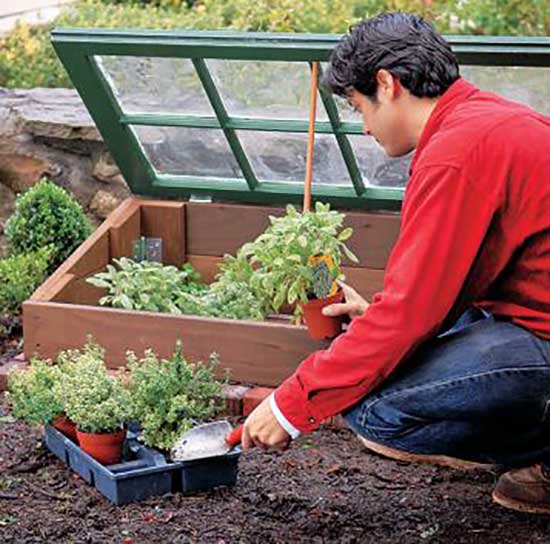 Salvaged Window Cold Frame. source
Salvaged Window Cold Frame. sourceIf you’ve redone the windows in your house recently, or have a store locally who sells salvaged pane windows, this project is for you! This makes a beautiful addition to the winter garden, and the panes of glass easily keep snow from reaching your fragile plants.
| Materials: | Salvaged window, lumber, misc bolts/hinges, tools |
| Dimensions: | Variable, depends on size of salvaged window |
| Difficulty: | Beginner to intermediate |
| Cost: | $$ |
Build This Cold Frame >
Old Window Cold Frame
 Old Window Cold Frame. source
Old Window Cold Frame. sourceAnother idea using salvaged windows, this cold frame is built much taller, enabling it to be used for larger plants. The windows fold open from the center to the outsides, making it surprisingly easy to vent on a warmer day.
| Materials: | Salvaged window panes, lumber, misc bolts/hinges, tools |
| Dimensions: | Variable, depends on size of salvaged windows |
| Difficulty: | Beginner to intermediate |
| Cost: | $$ |
Build This Cold Frame >
Compact DIY Cold Frame
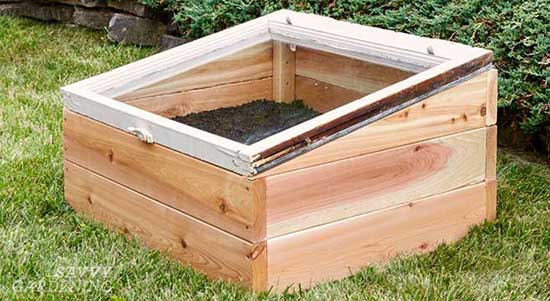 Compact DIY Cold Frame. source
Compact DIY Cold Frame. sourceThis smaller cold frame uses a single-pane reclaimed window as its top, and 2×6 boards to make up the sides. Thicker than most plywood frames, it does a really good job at keeping warmth inside!
| Materials: | Reclaimed window, lumber, hinges and misc screws |
| Dimensions: | Depends on window, but example is 32”x32” |
| Difficulty: | Beginner |
| Cost: | $ |
Build This Cold Frame >
Missouri Extension Cold Frame

Not only does this plan provide guidance in building a serviceable cold frame, but it teaches you how to build a “hotbed”, where more material (generally compost) is piled up around the sides of the cold frame to add extra insulation. Hotbeds are fantastic in very cold environments, as the warmth of the compost itself will keep the plants safer.
| Materials: | Glass sash, polyethylene or fiberglass for the top, lumber for the rest, needs hinges and assorted screws |
| Dimensions: | 3’ wide by 6’ deep |
| Difficulty: | Beginner |
| Cost: | $$ |
Build This Cold Frame >
Vertical Cold Frame
 Vertical Cold Frame. source
Vertical Cold Frame. sourceThis vertical cold frame is constructed almost completely of repurposed window frames, making it a great upcycling project as well! Built to rest against a wall, it is half-greenhouse, half-cold frame, and all very useful.
| Materials: | Reclaimed windows, lumber, misc hinges and screws |
| Dimensions: | Variable depending on windows used |
| Difficulty: | Intermediate |
| Cost: | $ |
Build This Cold Frame >
30 Minute Cold Frame
Straw bales and old windows? Absolutely! This technique is not glamorous, but it is fast, warm, and functional. If you’ve got straw bales lying around, along with some large old windows, you can have one of these assembled in no time at all.
| Materials: | Straw bales, large reclaimed windows |
| Dimensions: | Varies depending on bale count and size of windows |
| Difficulty: | Beginner |
| Cost: | $ |
Build This Cold Frame >
Pallet and Window Cold Frame
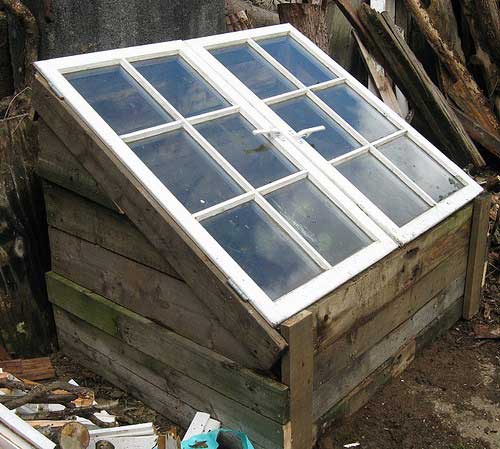 Pallet and Window Cold Frame. source
Pallet and Window Cold Frame. sourceThis upcycled pallet and window cold frame might be free, if you have a source of used pallets and windows! With a little ingenuity, you can have a very workable cold frame that will offer lots of protection to your plants for very little cash outlay.
| Materials: | Old pallets, reclaimed windows, nails or screws |
| Dimensions: | Variable depending on parts available |
| Difficulty: | Beginner |
| Cost: | $ |
Build This Cold Frame >
Brick and Window Cold Frame
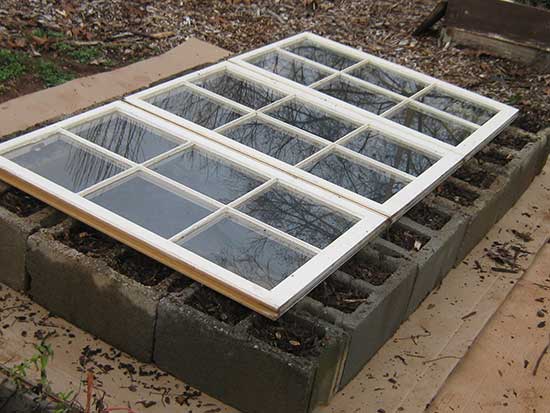 Brick and Window Cold Frame. source
Brick and Window Cold Frame. sourceUsing cinderblocks or bricks and old windows, you can construct a cold frame that can easily be broken down into its component parts once the cold season is over, and stored away for future use. It’s nothing fancy, but protecting your plants does not have to be!
| Materials: | Cinderblocks or bricks, reclaimed windows |
| Dimensions: | Variable depending on window size |
| Difficulty: | Beginner |
| Cost: | $ |
Build This Cold Frame >
Hinged-Top Cold Frame
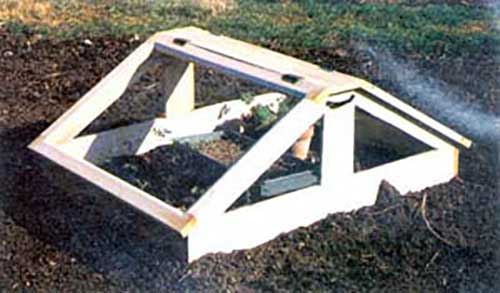 Hinged-Top Cold Frame. source
Hinged-Top Cold Frame. sourceThis great cold frame looks fantastic in the garden, and can be made using a wide variety of materials. While they used glass panels for theirs, you can do it with UV-resistant Lexan or plexiglass just as well. It does require a little more skill to build, but when it’s in place, it looks finished and clean.
| Materials: | Glass (alternately Lexan or plexiglass), lumber, dado set, screws or nails, hinges, misc other equipment |
| Dimensions: | Variable, depends on size you need |
| Difficulty: | Intermediate |
| Cost: | $$$ |
Build This Cold Frame >
Brick Cold Frame
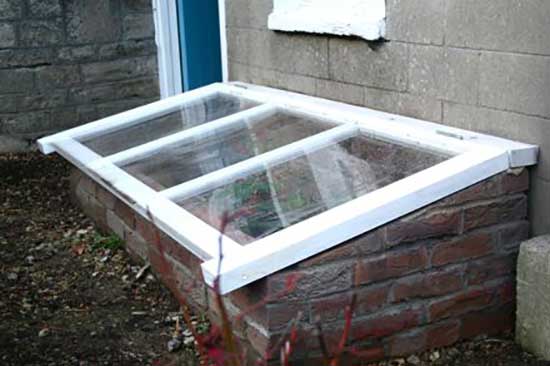 Brick Cold Frame. source
Brick Cold Frame. sourceThis cold frame is a permanent structure, as the bricks are in fact mortared together. However, the lid can always be lifted if the weather gets too warm. If you live in an area that has a short growing season, this might be perfect for you!
| Materials: | Bricks, mortar, window panels or lumber and plexiglass, screws and hinges |
| Dimensions: | Size not stated in piece, but easily adjustable |
| Difficulty: | Intermediate to difficult |
| Cost: | $$-$$$ |
Build This Cold Frame >
Shower Door Cold Frame
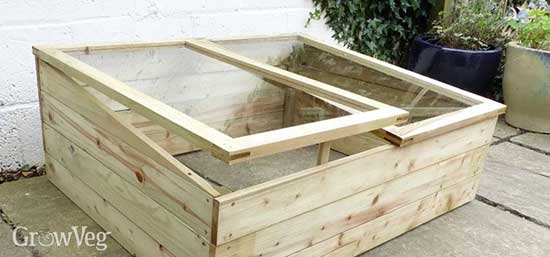 Shower Door Cold Frame. source
Shower Door Cold Frame. sourceYou can use a repurposed glass shower door for this project, or if you can’t find one of those, use old window panes. An easy step-by-step video shows you the process, and it’s a quick and easy build.
| Materials: | Old glass shower door or windows, lumber, screws, hinges |
| Dimensions: | Varies depending on size of top |
| Difficulty: | Beginner |
| Cost: | $$ |
Build This Cold Frame >
So, if you want to have fresh lettuce or spinach all winter, would like to keep those flowers from freezing, or just want to experiment with early seed starting, there’s a cold frame here for everyone! Do you use a cold frame for winter gardening, and if so, did you build your own? Tell us all about your frame in the comments!








